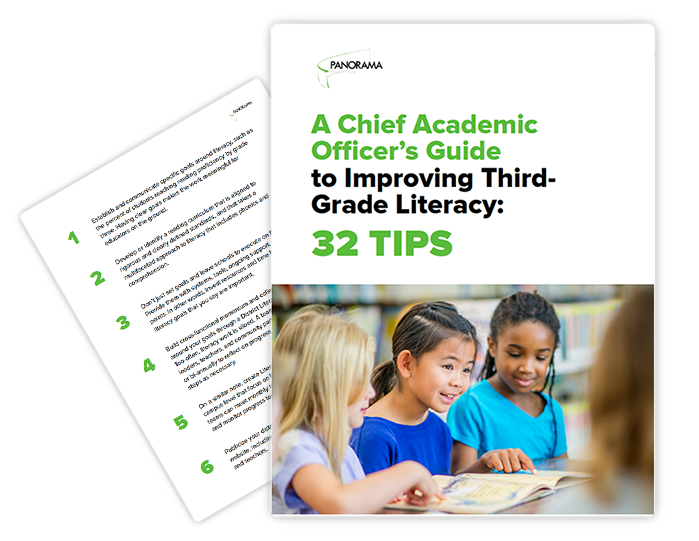As school and district leaders, what can we do now to address potential learning losses in student literacy upon return to school? How can we move forward knowing that there may be literacy gaps?
With the shift to distance learning, many of us are now taking a hard look at our school or district literacy plans. Teaching struggling readers will undoubtedly look different in the fall—and it's critical to adapt and adjust.
We sat down with Heather Fuger, elementary school principal at Iowa's Central Lee Community School District, and Emily Maciá, former principal at Achievement First (NY) and Panorama Client Success Manager. Principal Fuger has been recognized by the state of Iowa for her work improving student literacy, and Principal Maciá designed and founded a specialized school model in New York to serve students with moderate to severe needs in reading and math.
Together, our literacy experts explain why it's important to have a strong school- or district-wide literacy plan in preparation for students' return to school. They also share tips for combatting potential literacy backslide during distance learning (and beyond) through targeted literacy interventions.
Download 30+ tips for improving third-grade literacy.
1. Celebrate students and families for doing what they can during this period of distance learning.
HF: We've been trying to motivate in every way we can by doing shoutouts to students who are engaging in online materials. When I hear from a mom or a dad who's still working, but they're still carving out time to read with their children, I'm giving kudos to them, too. We're also mindful that so much authentic learning is happening right now in students' lives at home. For example, I had a student do a presentation to display their new skills working on a farm. We're still focused on taking our kids where they are now and helping them grow in whatever situation they're in.
As leaders, we have to remember that we've all been through something. We need to be understanding and listen to what others have been through, to help us navigate to what's next. If we can start there and be intentional with each next step, we can get back on track and help our students feel successful. How can we be kind with students and families? We want to appreciate and applaud our families for doing the best they can during this time.
2. Understand how students and families are experiencing distance learning.
EM: Many districts are running distance learning surveys to understand and address family needs during this time. What is their stress level heading into the year? How effective has distance learning been for them? Are they coming back to school feeling more connected to teachers, or are they coming back needing some re-building of trust? What ideas do families have for their child's learning? During this time, families have become their child's teachers in many ways. What strategies have families used to engage their kids at home? How can we harness that and bring it back into the school day?
The same goes for students, asking questions like: How are you doing? How has distance learning served you? Have you made progress or gotten stuck? How connected do you feel to your teachers and to your school? The data can give you a baseline for where students are now, so you can make a plan for where you want them to be when they return to school.
3. Use student skills data to identify who might need the most support right now.
EM: If your school or district recently administered a Panorama student survey, you could reinterpret those results to see which students might need the most support during distance learning. There may be someone who needs more support and encouragement than ever before. The student skills data can prompt conversations about who is best positioned to follow up with those students. Can it be a teacher, a counselor, advisor, or an adult who has a relationship with the student?
My second recommendation is to start thinking about the student skills information you need in preparation for back-to-school. What is the data we need to start collecting so that teachers, students, and families are ready for whatever our fall looks like? Consider using a student well-being survey or a student survey now to put your teachers and staff in a better position to support students now and in the fall.
4. Take a look at which literacy interventions have been working. Focus on those interventions for next school year.
HF: One of the things we're doing at Central Lee right now is taking inventory of our most effective literacy interventions for word accuracy, fluency, and other skills. What interventions were working the best before school buildings closed?
When it comes to next school year, we can't afford to wait for six weeks to see if an intervention is working. We need to focus on the interventions that we're good at and that have already been successful for our students... and let go of the interventions that aren't working.
We're using intervention data from Panorama to determine what we'll use with our struggling readers next school year. Panorama makes it so simple to do that. We used to have all of these papers and Google Sheets to cobble together intervention data. Now, with the click of a few buttons, we can get numerical data to see if a specific intervention helped students get to their next benchmark, or not.
We're also using anecdotal data from teachers. Teachers can take notes in Panorama on how easy or doable an intervention is: Do kids get bored with an intervention? Is this intervention doable three times a week? Our leadership team will look at that data to plan for which interventions we will or will not use next school year.
5. Consider which Tier 2 interventions may become part of Tier 1 next school year.
EM: If you have Tier 2 interventions that worked last year, it might be time to think about scaling some of those interventions in the coming school year, because we know that's what all students will need. For example, in elementary school, do literacy circles become a universal support? When we think about middle school and high school, what are the text guides or guiding questions that we're putting in the hands of all students to get them back in the habit of analyzing text?
6. Have a plan for how to make-up missed content next school year.
HF: While are continuing to teach the Iowa Core Standards to the best that we can right now, we know that we're going to need to be very strategic going into the fall. We can't think about next school year as every other school year. We know that kids might miss certain units at the end of this year, so we've begun having conversations about how to turn things around with the information that we have. We're looking at how many students were engaged—was it half? Three quarters? With that information, and knowing what was missed, we can come up with a plan for how to use our minutes next year.
We're considering doing some formative assessments at the beginning of next year to give us some additional data along with screeners. We're also giving our teachers grade-level autonomy. If teachers know that kids needed to leave a certain grade level with a particular piece of content or standard, they can make a plan for how the next grade-level teacher will make up that content at the start of the year—remaining cognizant that time is limited and we need to pace intentionally to keep students on track.
EM: Another critical piece is investing just as much in teacher culture around literacy as we do with kids. When we head back into a fall—where we're going to be teaching readers who may not have all of the skills that they had last year—as educators, we're going to have to lean on each other to make sure that kids are really getting all of the key concepts they need. So we're not just jumping into fourth grade without thinking about the fact that they didn't really finish third grade.







